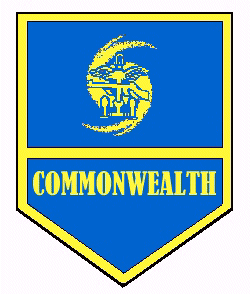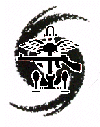Commonwealth Expeditionary Forces Ground Forces - 2303 AD By D Hebditch Acknowledgements The International Brigade concept (presented here as the International (East African) Brigade) is by Ben Aaronovitch. The Australian units and insignia are taken from Abraham Gubler's orbat. Thanks also to Bryn Monnery and the other members of the Etranger group. Narrative It was one of the largest offensives so far undertaken in 2303 and the last taken on by II Corps in the K-Zone before they handed over to the newly organised V Corps. The assaulting force was the usual array of troops drawn together for the task from the committed Commonwealth contingents and all were represented in the Command Post. The RGL recce troopers were led by a typically shaven headed, hollow eyed Warrant Officer just in from an OP overlooking the objective. He looked remarkably fresh and well for a man who'd just come from a month's deployment in the festering jungle. The stop groups were being provided by New African Commandos and the New Zealanders. The Commandos were hard eyed warriors full of hate for the aliens, many of whom had lost their families in the Occupation. The Kiwis on the other hand were all volunteers, professional soldiers who took pride in their skills and controlled aggression. Both were excellent battalions. The main assault force was from the heavy 1st Guards Armoured Brigade. Their officers crowded one end of the CP. The laid back, well educated sons and daughters of the far-flung aristocratic diaspora for the most part, they led tough, tightly disciplined British infantrymen as members of their families had done for centuries. Although they came from disparate origins together they were a formidable fighting force whose strengths combined to pose a mortal danger to the Alien invaders. Press Release, Information Department, New African Provisional Government 4th February 2303 Index
The military response of the colonial nations to the incursion of the Kafers into the French Arm was initially very limited. Conditioned by some 5 years of a bush fire border war at Eta Bootis the governments were rather complacent about the chances of a more active Kafer penetration. As a result when Triumphant Destiny launched an all out attack into human space the colonising powers struggled to organise and mobilise expeditionary forces to be deployed from the core. The battles of the Invasion on the colony worlds were largely fought by the forces already in place in the Arm. These were normally a mix of locally raised militias and lightly equipped regular reaction forces. Only on worlds like Beta Canum-4 and Kimanjano were mechanised human forces present in any real numbers and even these were outmatched eventually by Kafer ground assault units. It was only when the great powers began to impress substantial numbers of merchant ships did the situation begin to change, although at the expense of already dislocated trade. However with the outer colonies blockaded or taken there were large numbers of merchants available and willing to aid the military effort. Whilst the colonial powers of the region created expeditionary forces from their large Terran or Tiranean garrisons, smaller nations also wished to contribute for the defence of humanity. However they lacked the starlift capacity for independent operations and so usually opted to co-operate with one of the larger powers and place forces under their control. So although large numbers of human troops were available the early loss of Kimanjano meant that they were not able to pass beyond the Beowulf system. Consequently these forces flooded down to the surface where they conducted high intensity training and integrated various elements into new organisations, whilst also being prepared to defend the colony world. In the end though the Kafers never reached the surface, being defeated by Admiral Graham's Reserve Fleet. The savaging and defeat of the Kafer Fleet led to the immediate opportunity to counter-attack. Carried in a huge fleet of merchants along with their vast war stocks, the human ground forces rumbled out from Beowulf. The French led Liberation of Kimanjano occurred first against fierce opposition from Kafer space fighters in-system and from ground forces on the surface. Soon after the British led the return to Beta Canum to vastly reinforce the garrisons that had held on in remote places during the Occupation. These massive hammer blows were soon followed by smaller follow-up operations out along the fingers to Eta Bootis and 61 Ursae Majoris and to other minor colonies. Cut off from fleet support and logistical back up organised Kafer resistance was soon smashed by the heavily equipped human forces. However the remnants of these troops soon regrouped and tried to continue fighting a guerrilla war. On some worlds they were swiftly mopped up, whilst on others they have been able to survive in hostile and remote locations. Many colony worlds have bitter counter-insurgency operations underway. Virtually all of the liberated colony worlds were in an appalling state of humanitarian disaster and several worlds had been subjected to attempted genocide. With the Kafer fleets in retreat and human troops victorious the main effort changed from the military liberation to the reconstruction of the colony worlds. The merchant ships were swiftly reassigned to the movement of humanitarian supplies. Most of the military were stranded on worlds and consigned to defensive and civil aid tasks, while other contingents returned home to the core. Only small reaction ground forces with integral starlift retained their strategic mobility. Whilst some human politicians and military leaders are demanding large scale punitive expeditions into Kafer Space, the bitter fact is that the battered human space forces currently lack the capacity for such an incursion. Whilst the merchant fleet needed to support such a move and carry ground troops is fully employed rebuilding worlds and the colonial economies. Currently humanity's military dispositions are defensive ones. Most troops are deployed on the key hub-worlds able to support them while only small garrisons are located on the harder hit, marginal colony worlds. Local forces are being raised to supplement the core raised regulars and in some places replace them. Military leaders are unworried by the prospect of loosing the hub worlds but fear another Kafer incursion along the battered Eta Bootis finger and the possibility of politically expedient but militarily costly counter-attacks to free them.
Commonwealth Expeditionary Forces HQ The CEF HQ was established to control the initial build-up of British and Wellonese forces after the fall of Kimanjano. The Wellonese had long signalled their willingness to contribute to the war effort against the Kafers, but lacked the logistical assets and experience to deploy these forces without British help. The Alicians swiftly indicated their desire to join such a body, especially as their colony was to become such a major military staging post. From these small beginnings several other Old Commonwealth nations and British allies were also drawn into the organisation. Australia had largely relied on RSN logistics to deploy her expeditionary squadron and saw the value of co-operating in the long supply chain. Canada followed suit, as did several other non-starfaring nations. America's war effort on the French Arm being mostly undertaken unilaterally (whilst co-operating with the other nations, especially France) has also come to rely on the economies of scale provided by the CEF system. CEF HQ was established at Heorot on Alicia in the Beowulf system in February 2302. It is essentially a collegiate talking shop and clearing house co-ordinating the work of the rear area commands of the individual nations expeditionary contingents. The CEF has a joint command of an Army General and a Space Naval Admiral, this concentration of rank is to ensure the diplomatic clout of the CEF when dealing with the French. The CEF HQ is multi-national although British officers are still just in the majority and many nations without major contingents also provide Staff Officers for the HQ. The CEF's main role is threefold. Ensuring the smooth delivery of troops and supplies from the Core to Beowulf. Making sure those supplies are then distributed properly to their intended destination. Most importantly it co-ordinates the work of the fighting contingents, avoiding duplication of effort whilst attempting to provide the most elegant command structures and minimising the difficulties caused by domestic political and diplomatic demands. Obviously the CEF is not always successful in this. The CEF has also swiftly become a half-way house between the demands of the front-line commanders and the home governments. Increasingly due to the communications time lag the CEF and individual contingent commanders are acquiring or acting with escalating levels of responsibility. This is causing some concern in home nations worried about political control of the military, but is vital to the swift and effective work of Commonwealth forces. |


